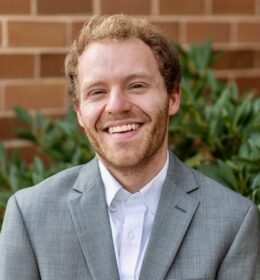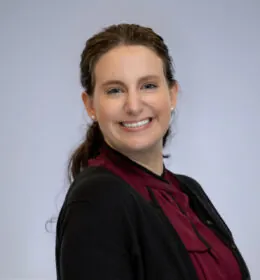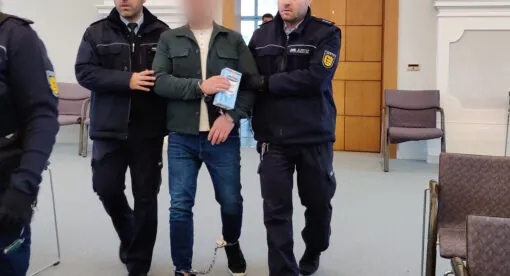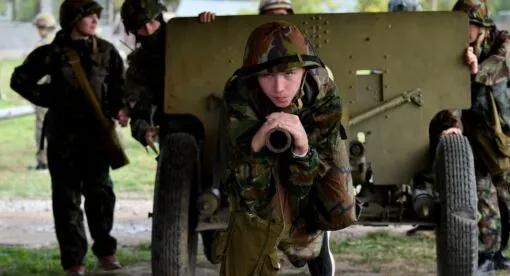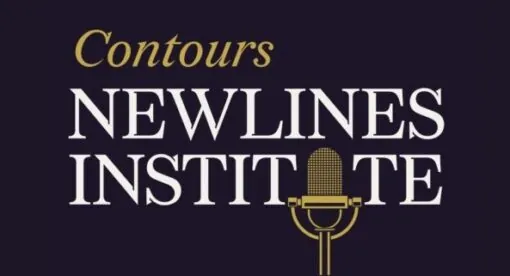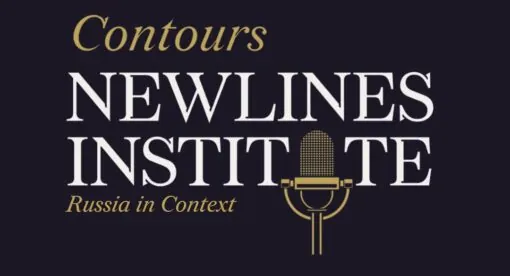In the latest Contours episode, host Carolyn Moorman sits down with experts Jerome Marston, Katherine Zimmerman, and Alexander Kochenburger to dive into the Yemeni civil war’s effects on Yemen’s education sector and if recent geopolitical developments, including a protracted cease-fire and Saudi-Iranian normalization, will allow for greater international focus on reconstruction efforts.
Carolyn Moorman:
Hello, and welcome to the Contours podcast by the New Lines Institute for Strategy and Policy. Today, we’ll be covering the Yemen conflict. I’m joined by a panel of three great guests to decipher this issue and what reconstruction efforts will bring for the country in the future, given the context of the current conflict.
Our first guest, Jerome Marston, is a senior researcher at the Global Coalition to Protect Education from Attack. He leads the research and production of the Education Under Attack report series and works to strengthen monitoring and reporting of attacks on education globally. Jerome holds a PhD in political science from Brown University, where he researched forced displacement in Colombian cities, supported in part by a Fulbright-Hays Grant. Jerome’s research appears in several academic journals as well as the op-ed pages of outlets like the New Humanitarian and El Pais.
Katherine Zimmerman is a fellow at the American Enterprise Institute, and an advisor to AEI’s Critical Threats Project. Her work is focused on terror groups, including the Salafi-Jihadi movement and the global Al-Qaeda network, as well as related trends in the Middle East and Africa. She also specializes in Al-Qaeda in the Arabian Peninsula and Yemen, Al-Shabaab in Somalia, and Al-Qaeda in the Sahel. Her analysis of terror groups and the countermeasures that need to be taken against them has been widely published, including in Foreign Affairs, the Wall Street Journal, and the Washington Post.
Lastly, Alexander Kochenburger is the analysis supervisor with the analytical development and training team at the New Lines Institute. His research focuses on the role of education reform and transitional justice and conflict transformation efforts. Before joining New Lines, Alex worked as a senior program assistant at Amideast, studied Arabic with the Center for Arabic Study Abroad Program, and completed a Fulbright Grant in Agadir, Morocco. He also interned with Search for Common Grounds Program Development Team for the Middle East, North Africa, and Asia.
Welcome to all of our guests. I would like to start this off with directing towards Katherine a request to give us an intro to the conflict itself, where we’ve been, where we’re going, and how you analyze current developments that have been happening recently, such as the April 2022 ceasefire between the Yemeni government and the Houthis and the ongoing negotiations between the Saudis and Houthis. Do you see these kinds of developments that have happened recently as steps towards a more permanent peace, a step towards peace at all? How do you analyze this?
Katherine Zimmerman:
Thank you for having me, and let me start just with saying that, within Yemen, the conflict has fundamentally frozen and we’re not seeing the types of violence that we had seen in years prior, but that doesn’t mean that a settlement is forthcoming or that the ongoing negotiations between the Iranian-backed Houthis and Saudi Arabia is going to result in any sort of peace inside of the country, and there are a lot of reasons for that.
Let me just take a step back and look at the Yemeni conflict overall. We often read about it in the media as a Saudi-Iranian proxy conflict or a war between the Houthis and the internationally-recognized Yemeni government, but there are many subnational issues at stake here and multiple actors fighting against one another and alongside one another to achieve different objectives. I just mentioned the Saudis, and of course, the Houthis involved in Yemen. The Houthis now control the majority of Northwestern Yemen and the majority of the population of Yemen, which is crucial to understanding how their power rests inside of this conflict.
The Saudis mobilized an international coalition, primarily made up of Gulf States and a couple of other Muslim partners, to go into Yemen at the Yemeni government’s behest to push out the Houthis, which they have failed to do in the past eight years of fighting. But that has largely meant that the Saudi military and the Emirati military were on the ground working with Yemeni forces as well, to combat the Houthis, and that coalition of Yemeni forces is a patchwork that goes across the country, but doesn’t actually unify it. And there was a significant development last year, in terms of what the Yemeni government looks like, that tried to stitch that patchwork of militias fundamentally into this quilt, this Presidential Leadership Council, the PLC, which has representation from each of the core power blocks that oppose the Houthis, but the momentum behind the founding of the PLC has fundamentally stalled.
There are growing signs that there’s intra-factional conflict again inside of Yemen, and rising concerns that members of Southern Yemen are going to look to actually secede or declare some sort of autonomous nature in the South, which is going to stoke additional conflict within the anti Houthi block and really create challenges in terms of the stability of the country. As we’re looking at all of that, we have to remember that there are incredibly local issues at play, there are national issues at play, and then, of course, there’s this regional conflict that’s playing out inside of Yemen as the Saudis are looking to Iran to try to get the Houthis to agree to a deal that really gives up some of the Houthis’ power to stabilize and bring peace to the region.
The broader context of what that means for Yemenis is that, even though they’re not living in violence day to day, this has been almost a cold war from the start in terms of civilian casualties, with the exception of the Saudi air campaign, but nothing like the Syrian Civil War, for example. But they have borne the brunt of a humanitarian crisis, a collapsing economy, the collapse and breakdown of critical infrastructure within Yemen, whether it be the health infrastructure or, as I think we’re talking today, the education system. And it just means that, even for Yemenis, should they come out of this conflict, they’re going to face significant hurdles, developmental hurdles, for the country to get toward any sort of long-lasting stability.
Carolyn Moorman:
Thank you, Katherine, for giving us a wonderful intro to the conflict, but also really laying the groundwork for the continuation of our conversation today on what those reconstruction efforts will look like and what work has to be done. One more question for you quickly, before we jump to another guest, is through your explanation of everything that’s been going on in Yemen and the multitude of actors that are involved and how all of these developments make this the jumble of confusion and difficulty that it is now, how has the Al-Qaeda in the Arabian Peninsula insurgency been impacted by this? Have we seen any key trends in the past couple of years, especially around the ceasefire period?
Katherine Zimmerman:
I will keep this brief because, as an Al-Qaeda analyst, this is my bread and butter, but when we’re looking at Al-Qaeda inside of Yemen, it’s really been operating outside, but also within this conflict. Just the brief history since the conflict began, as it started in 2014, AQAP, Al-Qaeda in the Arabian Peninsula, seized the initiative to take control of parts of South Central Yemen. And that means that they took Yemen’s third-largest port, Al Mukalla, in April of 2015 and expanded outward from there, so that within about six to eight months, they really controlled a significant swath of Southern Yemen. And, by control, they were actually governing by proxy through local actors.
The Emiratis, so it’s crucial that they were involved with the Saudis. They pivoted in 2016 to really looking at the counterterrorism front and worked with Yemeni actors to push AQAP out of the populated areas. They didn’t chase, and the Yemenis haven’t chased, AQAP out of the sanctuaries that it’s held since at least 2009, but the impact of a US-Emirati-Yemeni counterterrorism campaign on AQAP from 2016 really through its height in about 2018, ’19, is that the organization that was once known as Al-Qaeda’s most virulent franchise was the most degraded that I’ve ever seen it. It could no longer conduct, that we knew of, transnational attacks, with the exception of one noted in 2017, an attempt in Jordan. And, since then, it’s really sought to rebuild and reconnect the top leadership that had gone into hiding with the foot soldiers, who really are not the caliber that they used to be because there was a high turnover rate.
When we’re looking at the counterterrorism threat in Yemen, it persists. AQAP is seeking to rebuild its capacities. It will have the space, simply because the actors are otherwise distracted by their own prioritization on the ground, and because the Emiratis are not present in Yemen in the same way that they were, as they’re drawing out and trying to rebalance within the region themselves.
Carolyn Moorman:
Thank you, Katherine, for diving into what has really eclipsed this conflict since it began and giving us the framework to now direct this conversation towards what is next for Yemen and how can we create long-term stability for not only the conflict, but also the people that have been the most impacted through the attacks on infrastructure, all of the things that our next guests will be talking about.
Jerome, I’d like to turn to you and have you talk about how and why education comes under attack. In your work at the Global Coalition to Protect Education from Attack, you work on this very topic, and I’m specifically thinking of your 2022 Education Under Attack report, where you dove into some of the key countries and issue areas that are being attacked regarding education. So I’m wondering if you could give us a little bit of meaning as to these trends and maybe a little bit of insight into Yemen specifically.
Jerome Marston:
I would be happy to. First off, thank you very much for having me. Katherine and Carolyn, it’s great to meet you, and Alex, it’s great to see you again, and let me dive into that question. In 2020 and 2021, education came under attack more than 5,000 times. On average, that means six attacks on education a day. Those numbers are from Education Under Attack, as you mentioned, which is our flagship report, and it comes out every two years. GCPEA will not release a monitoring report for a little over a month, but I can say that the trend continued in 2022, and preliminary reports are showing that attacks on education increased that year, particularly in the context of Russia’s full-scale invasion of Ukraine.
To really get at your questions, let me talk about the forms that attacks on education take, heavily affected countries, and the motivations for attacks, and I’ll hit on Yemen in there as well. The attack forms: attacks on schools make up the majority of all attacks on education, and these include bombings, arson, looting, armed confrontations near schools, among others. But students and teachers are also targeted in attacks for their activism, union membership, or for being girls going to schools in some contexts. The occupation of schools and universities by government forces or non-state armed groups and their use of these facilities for military purposes, such as bases or as fighting positions, is also common. And other forms of attack on education include attacks on university facilities, students and professors, as well as sexual violence and child recruitment at or on the way to or from classes.
And so now talking about affected countries, attacks on education and the military use of schools and universities occur globally, but these are concentrated in conflict-affected countries. This last Education Under Attack report covered 28 conflict-affected countries, with Mali and Democratic Republic of Congo most affected, followed by Myanmar, Nigeria, Palestine, and others. And in the case of Yemen, GCPEA identified 185 attacks on education in 2020 and 2021 there, and these ranged from attacks on schools and universities to their occupation by armed forces and non-state armed groups for military purposes, as well as school-related child recruitment.
And then the question arises, well, what are the motivations for these attacks? Education comes under attack for various reasons, and these depend on the conflict and the perpetrator. In some contexts, government forces or non-state armed groups intentionally burn or loot schools or universities or target them with explosives because they oppose a certain type of instruction, such as Western, quote-unquote, education or girls learning. In other conflicts, armed groups view schools and their students and personnel as agents or symbols of a government that they oppose and so they boycott or attack them.
In yet other places, government forces and non-state armed groups occupy schools and universities and use them for tactical purposes, for example, as bases, barracks, interrogation centers, or for recruiting children. And, additionally, explosive weapons are really commonly deployed in cities and towns in conflicts around the globe, and in these cases, they either target schools or universities, or the wide area effects of these weapons impact education facilities and their learners and teachers.
Carolyn Moorman:
Thanks, Jerome, for going into so much needed detail about how much of a threat education being under attack is around the world and how much of a problem it is.
And, with that, I’ll turn to our third and final guest, Alex. In a recent piece that you wrote for New Lines called “Rebuilding for the Future: A Spatial Analysis of Education Reconstruction in Yemen,” you went into detail about the specific problems Yemen has had with its education system due to the conflict, and you used geographic information systems, or GIS, to develop this research. I’m wondering if you could please explain how you used your research to analyze the situation in Yemen and what areas of Yemen have been the most impacted by this?
Alexander Kochenburger:
Yeah. Thanks, Carolyn. It’s great to be part of this conversation with you, Katherine, and Jerome. I think, to answer your question, to pick up on what we heard from Jerome, really all of those forms of attacks on education have also been taking place specifically in the context of Yemen. We have direct attacks on schools by various government forces, armed groups, states in the region that have been active in Yemen. We have occupation of schools by armed groups that’s against teachers and then as well as recruitment of child soldiers directly from schools and the utilization of schools to host internally-displaced persons.
And the results of these forms of attacks on education really can be illustrated in several statistics, including, for example, that there are more than 2,500 educational institutions that are currently out of use as a direct result of the conflict throughout the country, and these institutions that are out of use are really clustered in certain governorates in Yemen that have seen very heavy fighting, such as Sanaa City, where more than 42% of educational institutions are currently out of use, Abyan, where more than 35% of educational institutions are out of use, and Sadah, where also more than 35% of educational institutions are out of use.
There have been more than 10,000 children recruited into various armed forces since 2014, and more than 4,000 of these were under 15 when recruited, which is a war crime according to the International Criminal Court. Roughly 50% of teachers have not received regular pay since 2016, according to Save the Children, which has led to an exodus from the industry in various provinces such as Al Jawf, Sanaa, Sanaa City, and Marib. More than 40% of eligible young women and girls are out of school. And really all this paints a very dire picture of education in the country and very high level of education reconstruction needs. And these various forms of attacks on education that, again, have contributed to very high [inaudible 00:16:49] of schools that are out of use, more than 10,000 children, again, recruited into various armed groups and armed forces, large numbers of teachers who have been forced out of the industry due to lack of pay and threats against them, and large numbers of young women and girls out of school.
All this, again, has really exacerbated levels of insecurity and human suffering in the country. It’s violated the right to education for young Yemenis, and also threatens to undo any long-term efforts to try and rebuild and stabilize the country, and is a major area for policymakers to be paying attention to, both policymakers within Yemen and, of course, across the world who are concerned with the reconstruction and with the future of Yemen.
The report looks at some of these different metrics and then uses geographic information systems, as you mentioned, to try and locate different governorates that have high areas of need according to these different metrics in the hope that that’s of use to policymakers to really try and visualize where and how education has come under attack in Yemen and what the reconstruction needs are of the country as a whole, but also specifically certain governorates. Obviously, conflict is not experienced equally across the country as a whole.
Carolyn Moorman:
I think it’s really important, your ending note, how it’s not experienced in every part of Yemen the same way, as the conflict has been totally different in multiple different ways between the actors, between the locals affiliated, between the humanitarian effects, in every stage of the war.
Jerome, as Alex also said in his response, there is a tension in the international community about this problem in Yemen, with the attacks on education, with needs to return Yemenis to have an opportunity to go to school, to have a right to education. Your organization, as far as many nonprofits, do work into protecting education as a right. What has been done on the international stage and what more can be done to make sure these commitments are fulfilled?
Jerome Marston:
Thanks for the question. And let me start by saying you are absolutely right that children have a fundamental right to education, including in conflict zones. And, if we aren’t ensuring that children receive education by either keeping schools open and safe or ensuring some form of distance learning or remote learning and/or providing education in internally displaced persons camps and et cetera, then we risk having a lost generation of students who aren’t learning. And then what does that mean, as Alex referenced, what does that mean for post-conflict reconstruction and so on? It just isn’t a feasible option to not have children learning given how protracted conflicts are these days.
With all of that, there’s a couple of steps that can be taken. The first one, which is really the key, is the Safe Schools Declaration. This is an intergovernmental political commitment that offers concrete commitments to safeguard schools and universities and their students and staff during armed conflict, and the declaration has been endorsed by 118 governments, this includes Yemen, and there is a community of practice around the declaration. This is led by the governments of Norway, Spain, Nigeria, and Argentina. And the community of practice is established to promote implementation of the declaration, share good practices in safeguarding schools and universities, and to ensuring that governments are meeting the commitments within the declaration.
And so to give just a couple of examples of what implementation of the declaration would mean, that would be updating domestic legislation and military manuals to protect schools from government forces using them for military purposes, for instance. Another key tool is the guidelines for protecting schools and universities from military use during armed conflict. And so these guidelines provide clear and simple guidance for armed parties to refrain from using schools and universities for military purposes, and these guidelines can be adopted and implemented by non-state armed groups as well as governments. Between the Safe Schools Declaration and the guidelines, we have most actors in armed conflict covered. And, again, here we are at the global level, as your question referenced.
Another tool is United Nations Action Plans. These are a commitment between the UN and parties listed as having committed grave violations against children in the UN Secretary General’s annual report on Children and Armed Conflict. And parties can be listed for attacks on schools and hospitals, and if they sign an action plan, they are given time-bound activities to stop attacks and prevent future ones. One example would be, in Yemen, the Houthis signed an action plan in 2022 to end attacks on schools, along with other grave violations against children.
And let me give another example or two from Yemen specifically. In 2021, the Ministries of Education in Aden and Sanaa adopted the National Manual for Safety and Security in Schools, which includes principles of school protection, such as preventing the use of school buildings by armed actors and otherwise respecting the right to the continuity of education. And this was done in collaboration with Safer Yemen, a security company and think tank, which has brought the two competing sides together to discuss the threats affecting school safety and encouraged an understanding of the general principles to protect school and the importance of continuing education.
Carolyn Moorman:
Taking what Jerome has laid out for us on international efforts that can and should be done to ensure children in Yemen have access to school as a fundamental right, Alex, I’m going to turn to you once again and see if, first of all, you have anything to add to the recommendations that Jerome gave. Maybe if you want to touch on how education reconstruction efforts can be targeted to be the most effective, given, as you said previously, that the conflict has affected different sections of Yemen differently. And, lastly, as I mentioned earlier, you used GIS software in your analysis for your piece for New Lines, and I’m wondering if you have any thoughts on how policymakers can view GIS as a tool when they’re thinking about reconstruction in general?
Alexander Kochenburger:
Yeah, definitely. Thanks, Carolyn. Starting with the question of, I guess, what can be done in Yemen to protect education from attack, I think Jerome is exactly right and gave us a lot of great detail on what the next governing institutions of Yemen can do in terms of implementing the Safe Schools Declaration, also implementing the guidelines into national legislation and the different manuals of the armed forces really across the country, and that is certainly going to be a critical part of the puzzle to end the militarization of schools.
But one other thing that we mentioned in our report that we’ve talked about that was recently published, is not only rebuilding education infrastructure across the country, but doing so in a way that pays attention to some of the other issues that are occurring in the country. And, for example, one of the ways that these institutions cannot just be rebuilt or strengthened while paying attention to other issues is by essentially paying attention to the large number of young women and girls that are out of school and rebuilding educational institutions in ways that have separate facilities for different genders, encouraging the hiring and the promotion of female educators. And there will most certainly need to be more work done in the future to account for the special needs of female educators in this context, in many contexts.
But there’s been lots of research that has shown that, in Yemen, and even across the world outside of Yemen, that the enrollment rates of young women and girls increase when there are separate facilities for different genders, and more female educators. That will be a critical part of the puzzle as policymakers within Yemen and across the country start to think about rebuilding education infrastructure as not just rebuilding it, but doing so in a way that’s gender responsive and pays attention to other education and emergency issues that are occurring in the country.
And then, to answer your second question about the ways that GIS and geographic information systems can aid education reconstruction, I think there’s a lot that it can do. Our report kind of scratched the surface by essentially aggregating data on the governorate level, and there are 22 different governorates in Yemen, and trying to visualize, calculate where education’s been attacked and what the different needs are of different governorates. But there’s definitely room to go even deeper and perform a similar analysis on a district-based level, which there are over 330 districts in Yemen, and really try and get more specific about the very specific areas of need within Yemen according to different education metrics.
And there’s also a lot that GIS can do in terms of trying to find locations for new schools too, as policymakers start to think about where schools should be built, and maybe not just rebuilding them in the same old locations, but potentially finding new locations for schools. There’s a lot that GIS can do in terms of performing suitability analysis to find locations for new schools that are, for example, closest to the highest number of school-aged children and young women and girls to lower their commute to school, that are on flat land and less of a danger for flooding, that are in safer neighborhoods. There’s a lot that GIS can do, not only in visualizing areas of need as this report did, but also in starting to plan even more for the future and trying to identify optimal locations for schools and a variety of other uses.
Carolyn Moorman:
With Alex’s wonderful response to how policymakers can use targeted GIS software to really shape reconstruction efforts in Yemen regarding the education sector, I’d like to ask our final question to Katherine and return to a geopolitical level of analysis. The Chinese-brokered Iranian-Saudi rapprochement deal that happened a couple of months ago made a lot of headlines, due in part to the obvious effects of Chinese diplomatic power encroaching on US power in the Middle East. But how do you see, given in the beginning, as you mentioned, the proxy-related element between Iran and Saudi Arabia that is part of the Yemen conflict, how do you see this deal, this kind of rapprochement that’s ongoing, affecting this in the long term? And do you think that this will cause any changes to make the efforts for reconstruction, the focus from conflict to reconstruction, happen anytime soon?
Katherine Zimmerman:
It’s a great question. I think there’s a lot of hope on the Saudi side that the Iranians will be effective in handling the Houthis, but the end of it, whether or not there’s a formal agreement between the two sides and the rapprochement continues, neither side, the Saudis specifically, and the Houthis, have an incentive to start fighting at this point, so long as the Saudis continue to pull out of the Yemeni conflict and pull back support for various Yemeni fighting factions. But, in terms of reconstruction, I think that the problem is going to be the role of the Houthis going forward, and whether or not they are going to be an actor representative of the people in Yemen. There are reports coming out, the way the Houthis have changed education, for example, they have rewritten textbooks and have militarized the schools to effectively start indoctrinating young Yemeni men, boys, at a very early age to their cause.
And these boys who’ve now lived, they’ve been under eight years of war, so, if you start as a child, you’re now a young man, and there’s a lot to be said about how time changes perception, and I think that’s one of the core challenges that we face in Yemen, is the way that the Yemeni fabric of society has been pulled apart by various forces, the Houthis being one, of course, and the various identity groups that have formed that are going to impede reconstruction and fight for the allocation of resources.
I think it’s very obvious that Yemen will not get sufficient resources from the international community, just given the number of both humanitarian crises and the development requirements in various conflicts across the world and how underfunded even the Yemen funds are today. What that basically means is that we’re going to see too few funds for a very big problem, that are going be unfairly divided within a population in need. And so the biggest fear is that, as we launch into reconstruction, at whatever point it is, the introduction of new resources also introduces a new dynamic into the conflict that reinjects and reinvigorates some of the factions to try and vie for access to those resources.
Carolyn Moorman:
Thank you, Katie. I really appreciate you ending this with a bird’s-eye view of what we can expect in the ongoing future in the Yemen conflict, and the difficulties ahead for not only Yemen itself and the actors involved in it, but also the international community in attempting, as you mentioned, with very limited funds already, to reconstruct a state of society that is positive for the region and also the Yemeni people.
I want to thank the three of you for joining us on this podcast today. To our listeners, thank you for listening to this episode of Contours. Make sure to subscribe to the podcast on major streaming platforms, including iTunes, SoundCloud, and Spotify, so you don’t miss any of our new podcasts. You can also check out further analysis into geopolitics and US foreign policy at www.newlinesinstitute.org. All the best.


